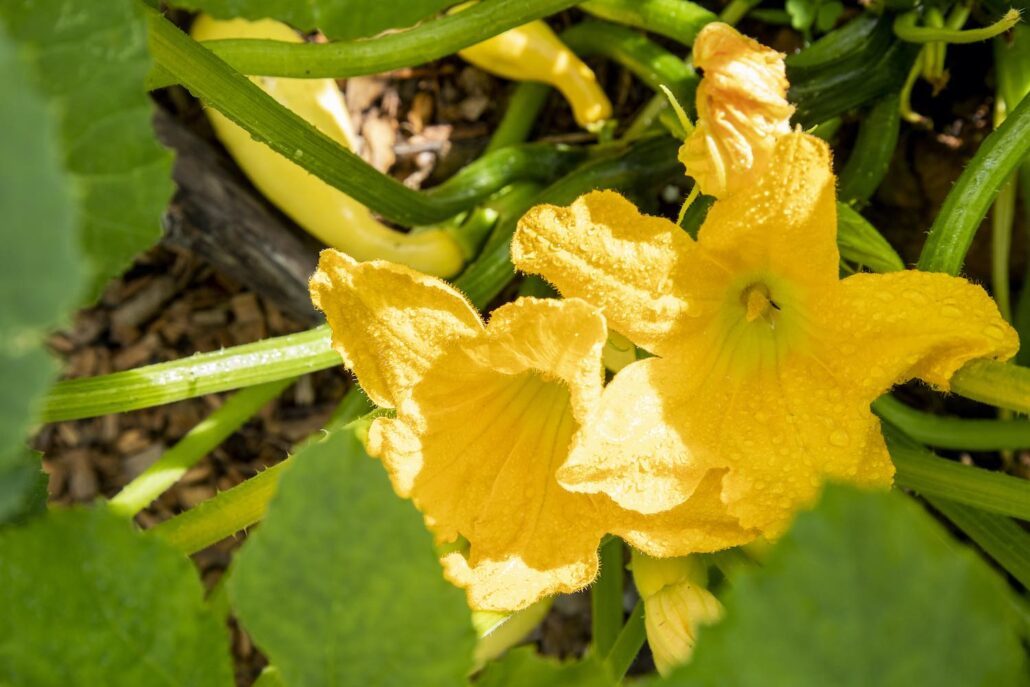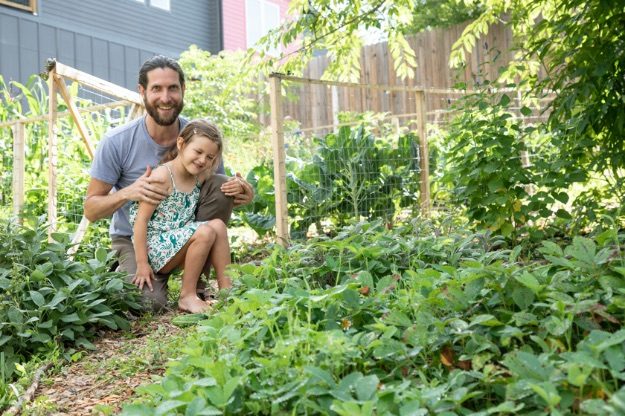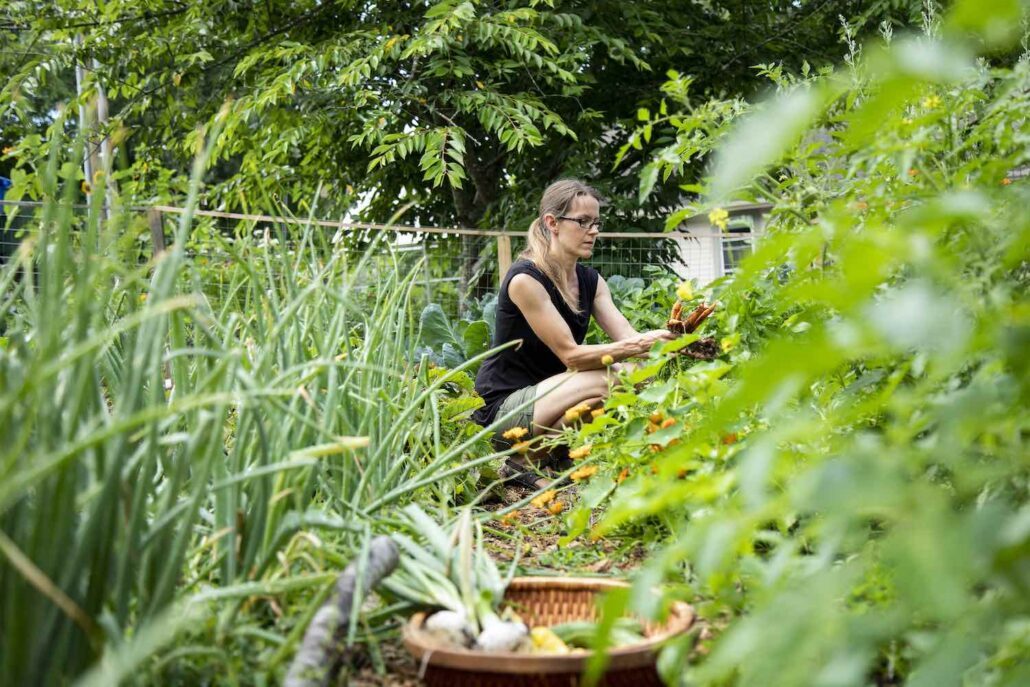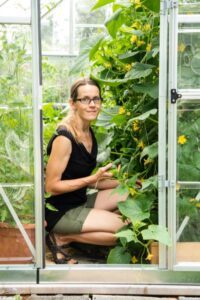Presented by Mother Earth Food
THE FLAVORS OF 50 MILES
How one local woman sources her family’s diet within 50 miles of Asheville
BY MARI JYVÄSJÄRVI STUART | PHOTOS BY ERIN ADAMS
THE SUMMER HARVEST- The Second Chapter in a Four-Part Series
This year, we brought home the activities that used to take place elsewhere: work, school, entertainment—and even food production. In the spring, walking in my neighborhood, I saw people who had never gardened before digging vegetable gardens and building raised beds. Amidst uncertainty about the future, and also food supply chains, we did what our ancestors have always done: plant food.
Our family already had a garden, but we were by no means immune to this impulse. My husband Dan and I expanded the fenced-in garden area, planted five times as many seedlings as before, and increased the number of our backyard chickens to four. And then, during those quarantine days—when coming up with house projects while avoiding going to the store became something of a national sport—we built a long, terraced bed for potatoes with scrap materials we had lying around. I’m Finnish, and to me nothing says “food security” like a long row of potatoes, the staple food on which my ancestors survived. That ridiculously warm, comforting feeling I felt in my chest when admiring this new potato bed; that was genetic memory in action. If nothing else, we’d have a few weeks’ worth of potatoes to eat in the summer.
Now that summer is here, it has become clear that grocery stores are not going to run out of food anytime soon and there is, in fact, no need to resort to a survivalist diet of potatoes. But the springtime push to get more plants in the ground, to get involved in growing more of what we eat, feels anything but wasted. This year has made clear the need for economic and climate resilience in our communities, and to me, the skills we build in our gardens absolutely contribute to that resilience. As rewarding as it is to eat from a garden full of food, the more significant “harvest” is the sense of empowerment that comes from being involved in producing food for oneself and one’s community, and being a little less dependent on long and often compromised supply chains. Sourcing my food within a 50-mile radius—a project I started last September—feels as timely as ever.

What to make with all of that seasonal, fresh produce that we’ve grown in our “Covid gardens” or found at farmers’ markets?
We have developed a dependence on imported and processed foods in part because we’ve forgotten how to grow food ourselves or source it locally. But it’s also because many people don’t know what to do with local, seasonal food once they have it. Cook- ing from scratch and being able to create a meal with what’s at hand are increasingly rare skills. So is knowing the basic processes of food preparation and preservation, such as making stock and broth, yogurt and butter, bread and preserves—what some people call “grandma skills.”
The COVID crisis revived some of those disappearing arts of cooking from scratch, as homebound citizens turned to baking sourdough bread and making ravioli to pass the time. But the pull of convenience-driven processed food has by no means lost its power. Maintaining and cultivating our kitchen savvy takes continuous practice.
A basketful—or a gardenful—of fresh summer produce is a great opportunity to practice.
Here’s the good news: many of the best summery garden dishes are elegantly simple. That’s because fresh summer vegetables and fruit are full of complex flavors and need minimal preparation to bring out their richness.
Think about fresh pesto, for example. Freshly puréed, fragrant, sweet-spicy basil leaves are packed with such powerful flavor compounds that a little salt, garlic, olive oil and good grated cheese are all that’s needed to create a swoon-worthy summer dish.
Or think about the proverbial homegrown tomato, still warm from the sun, or the perfect combination of sweetness and tartness in the first strawberries and raspberries of the season. As summer cooks, our role is mostly getting out of the way and letting the ingredients shine.

Sourcing those ingredients fresh, either from the garden or from a local small farm, is what creates the satisfying, unique flavors. The produce at grocery stores has been shipped from afar and is already several days past its harvest. Fruits and berries have been picked too early and artificially ripened. Rarely, if ever, does one get to see culinary treats harvested from plants at their various stages—garlic scapes, zucchini blossoms, or beet greens—on grocery store aisles.
Lastly, the produce we do find at stores usually represents the same handful of varieties that have been bred mostly for convenient harvest, packing, and storage, not for flavor. Contrast that with local seed company Sow True Seeds’ 29 different varieties of peppers or 45 varieties of tomatoes. If their names alone make you curious about the story behind that variety—like the “Sweet Banana” pepper or the “Cosmonaut Volkov” tomato—just imagine what nuances of color and flavor they offer.
Here are some of my family’s go-to summer dishes that incorporate garden produce and other local ingredients.
Potatoes: My ancestral food security staple, potatoes are a perfect example of simple satisfaction. All you need to accompany new potatoes is some salt, butter, and fresh dill. A potato salad with its many variations is another instant hit, and a great way to incorporate other vegetables that happen to ripen at the same time.
Pasta: A great base for all kinds of garden-fresh meals. Locally sourced pasta is surprisingly easy to make. I hand-crank mine with a pasta maker using Carolina Ground flour and local eggs. To that base, one can add pesto, which can also be made 100% local if you use local walnuts instead of pine nuts, local Acornucopia nut oil instead of olive oil, and grated local cheese. Once the tomato crop comes in, it can be turned into your favorite kind of tomato sauce, or a fresh pasta salad tossed with cherry tomatoes, herbs, and cheese.
Summer Squash: If you’re a gardener, you know the infamous season of the summer squash. Every summer, I kick myself for once again planting too many zucchini and yellow crookneck squash plants and exhaust the archives of cooking blogs trying to think of yet another dish to use them in: zucchini fritters; zucchini bread; slow-cooked zucchini coins with herbs and homemade feta cheese on top of pasta; spiralized zucchini pasta. My favorite approach these days is to throw them on the grill along with other summer vegetables, like peppers, string beans, and cherry tomatoes.
Quiche: This is another dish that lends itself well to local eating. You can make the crust with Carolina Ground flour and Mills River Creamery butter. The filling can be made with leeks sautéed in butter, or local oyster mushrooms and peppers, or just about anything you have available, completed with a custard of eggs and cream.
Vegetable Soup: Pureed vegetable soup is another simple template with endless varieties. Our summer favorites include potato leek soup, tomato carrot soup, and beet soup. A flavorful stock, half a cup of local cream, and some fresh herbs make these soups rich and satisfying.
The months of July and August bring the feasts of grilled corn cobs, tomatoes, green beans, peppers, and eggplants that will make a complete meal with local grits or potatoes and a side of meat or fish. And to round off a hot day, there’s nothing like garden-grown refreshments like a watermelon “slushie”—frozen watermelon cubes blended with a bit of fresh mint—or home-made ice cream made with Mills River Creamery cream and fresh local berries.

Even during this season of abundance, I have run into some challenges in my efforts to source a local diet. It’s become clear that, for health reasons, I need to minimize gluten. Yet, as the above list of summer favorites makes clear, many of my go-to meals involve wheat in some form or another. Just last year, I gleefully discovered a local source of wheat at a local farm. Now it feels as though I’m back to square one, as most gluten-alternative grains are imported. That’s the case at least with quinoa, buckwheat, and almond and coconut flours.
Since I may not be the only one on a quest for local gluten-free options, let me share some of my recent discoveries. One option is to find locally grown and milled corn flour or grits, such as those sold by Barkley’s Mill in Weaverville. Lee’s One Fortune Farm in Marion, meanwhile, grows several different types of rice. Acornucopia’s acorn flour is another gluten-free option. I also planted buckwheat and quinoa in my garden. While quinoa does not thrive in our region, buckwheat does. A relative of quinoa, lambsquarters, also produces edible and highly nutritious seeds that used to be a diet staple of the Cherokee.
I cannot possibly grow and process a year’s worth of gluten-alternative grains on our urban lot, nor would it make sense. Instead, we can create the conditions in which new kinds of crops and enterprises can thrive in our region. Perhaps someone in our area is already dreaming up a buckwheat and lambsquarters farm and processing facility? When you start sourcing your diet locally, entire landscapes become alive with possibilities. ◊◊
Mari Jyväsjärvi Stuart is an ecological landscape designer, teacher, and carbon farm planner. She is the program director for Co-operate WNC’s new community-supported regenerative farming initiative, Carbon Harvest. She teaches modern homesteading skills in her community and writes about them at groundedlife.co.
Save
Save
Save
Save
Save
Save
Save
Save
Save
Save

Mari Jyväsjärvi Stuart
THE WEEKLY REVEL
Sign up for your free handpicked guide to enjoying life around Asheville.
Available weekly from May to October.





